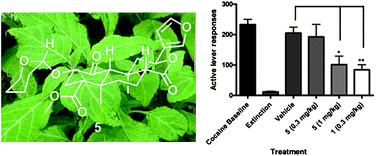Potential drug abuse therapeutics derived from the hallucinogenic natural product salvinorin A†
Abstract
Previous structure–activity relationship studies of

* Corresponding authors
a
Department of Medicinal Chemistry, University of Kansas, 1251 Wescoe Hall Drive, Malott 4070, Lawrence, KS, USA
E-mail:
prisinza@ku.edu
Fax: +1 785 864 5326
Tel: +1 785 864 3276
b Small Molecule X-Ray Crystallography Lab, University of Kansas, 1251 Wescoe Hall Drive, Malott 6044, Lawrence, KS, USA
c Nuclear Magnetic Resonance Laboratory, University of Kansas, 1251 Wescoe Hall Drive, Malott 3002, Lawrence, KS, USA
d Clinical Psychopharmacology Section, National Institute on Drug Abuse, National Institutes of Health, 333 Cassell Drive, Triad Building, Suite 4400, Baltimore, MD, USA
e School of Biological Sciences, Victoria University of Wellington, P.O. Box 600, Wellington, New Zealand
Previous structure–activity relationship studies of

 Please wait while we load your content...
Something went wrong. Try again?
Please wait while we load your content...
Something went wrong. Try again?
K. M. Prevatt-Smith, K. M. Lovell, D. S. Simpson, V. W. Day, J. T. Douglas, P. Bosch, C. M. Dersch, R. B. Rothman, B. Kivell and T. E. Prisinzano, Med. Chem. Commun., 2011, 2, 1217 DOI: 10.1039/C1MD00192B
To request permission to reproduce material from this article, please go to the Copyright Clearance Center request page.
If you are an author contributing to an RSC publication, you do not need to request permission provided correct acknowledgement is given.
If you are the author of this article, you do not need to request permission to reproduce figures and diagrams provided correct acknowledgement is given. If you want to reproduce the whole article in a third-party publication (excluding your thesis/dissertation for which permission is not required) please go to the Copyright Clearance Center request page.
Read more about how to correctly acknowledge RSC content.
 Fetching data from CrossRef.
Fetching data from CrossRef.
This may take some time to load.
Loading related content
